automatic transmission JAGUAR S TYPE 2005 1.G Technical Guide Update
[x] Cancel search | Manufacturer: JAGUAR, Model Year: 2005, Model line: S TYPE, Model: JAGUAR S TYPE 2005 1.GPages: 133, PDF Size: 3.48 MB
Page 9 of 133
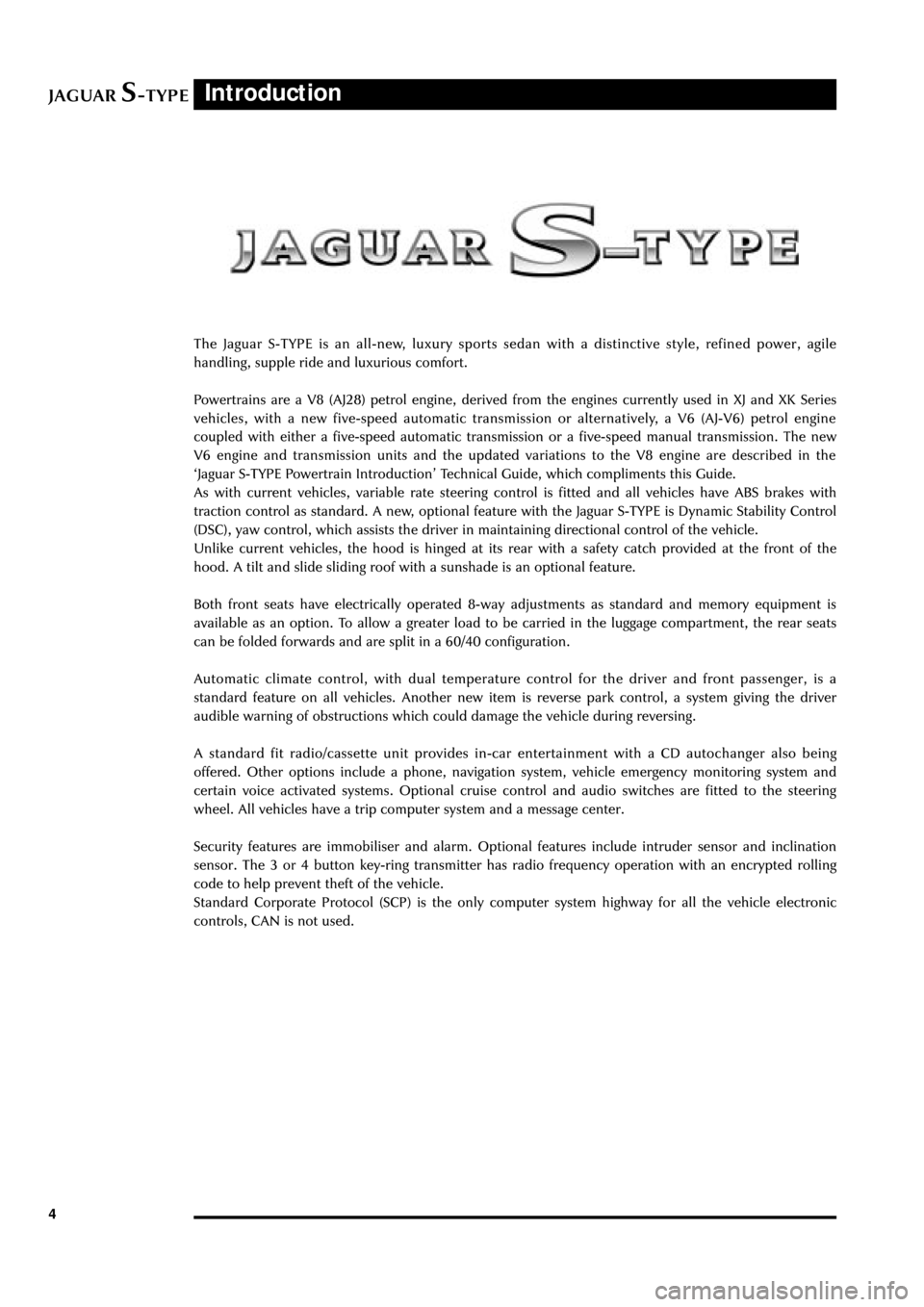
JAGUARS-TYPE
4
Introduction
The Jaguar S-TYPE is an all-new, luxury sports sedan with a distinctive style, refined power, agile
handling, supple ride and luxurious comfort.
Powertrains are a V8 (AJ28) petrol engine, derived from the engines currently used in XJ and XK Series
vehicles, with a new five-speed automatic transmission or alternatively, a V6 (AJ-V6) petrol engine
coupled with either a five-speed automatic transmission or a five-speed manual transmission. The new
V6 engine and transmission units and the updated variations to the V8 engine are described in the
ÔJaguar S-TYPE Powertrain IntroductionÕ Technical Guide, which compliments this Guide.
As with current vehicles, variable rate steering control is fitted and all vehicles have ABS brakes with
traction control as standard. A new, optional feature with the Jaguar S-TYPE is Dynamic Stability Control
(DSC), yaw control, which assists the driver in maintaining directional control of the vehicle.
Unlike current vehicles, the hood is hinged at its rear with a safety catch provided at the front of the
hood. A tilt and slide sliding roof with a sunshade is an optional feature.
Both front seats have electrically operated 8-way adjustments as standard and memory equipment is
available as an option. To allow a greater load to be carried in the luggage compartment, the rear seats
can be folded forwards and are split in a 60/40 configuration.
Automatic climate control, with dual temperature control for the driver and front passenger, is a
standard feature on all vehicles. Another new item is reverse park control, a system giving the driver
audible warning of obstructions which could damage the vehicle during reversing.
A standard fit radio/cassette unit provides in-car entertainment with a CD autochanger also being
offered. Other options include a phone, navigation system, vehicle emergency monitoring system and
certain voice activated systems. Optional cruise control and audio switches are fitted to the steering
wheel. All vehicles have a trip computer system and a message center.
Security features are immobiliser and alarm. Optional features include intruder sensor and inclination
sensor. The 3 or 4 button key-ring transmitter has radio frequency operation with an encrypted rolling
code to help prevent theft of the vehicle.
Standard Corporate Protocol (SCP) is the only computer system highway for all the vehicle electronic
controls, CAN is not used.
Page 11 of 133
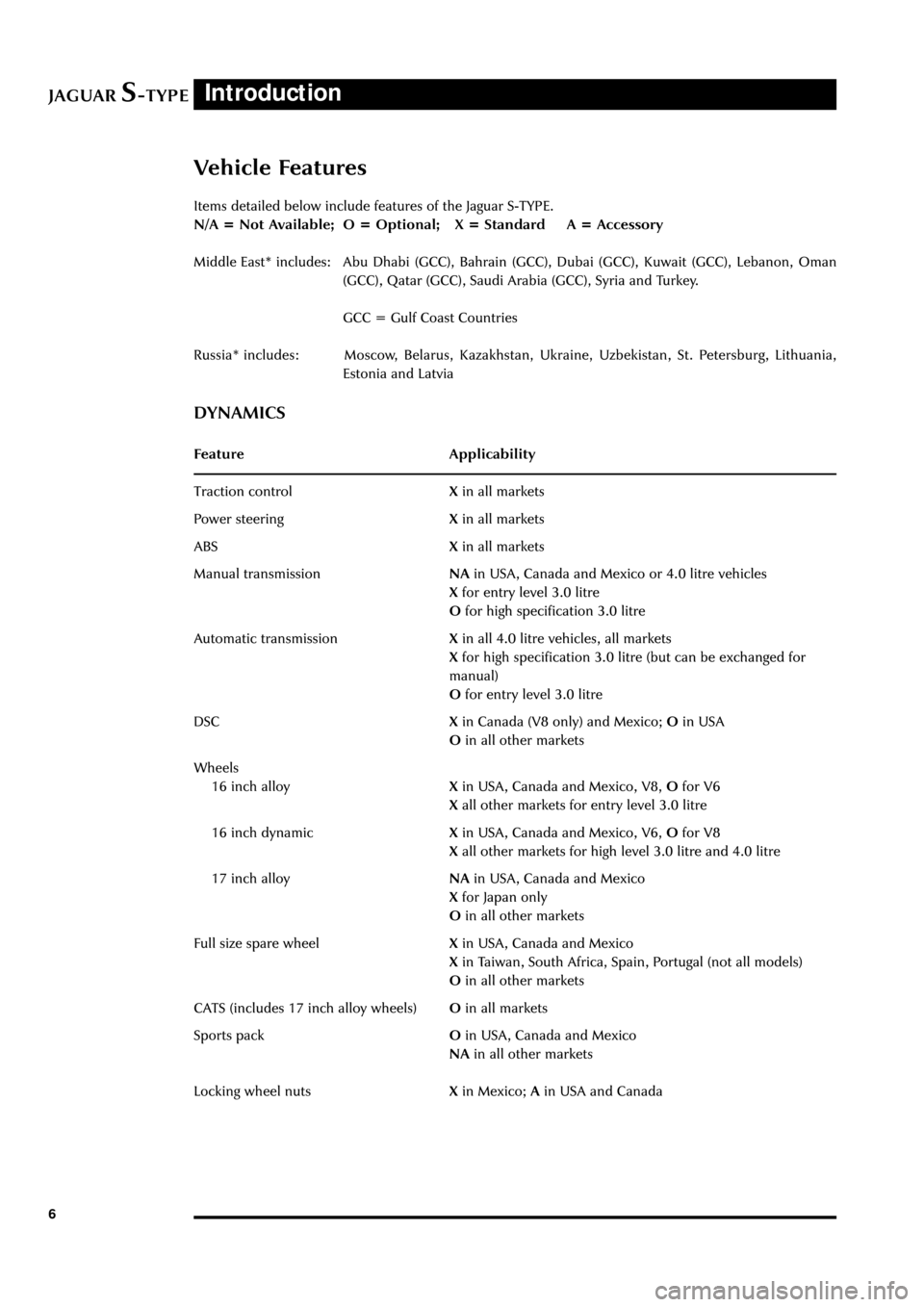
JAGUARS-TYPEIntroduction
6
Items detailed below include features of the Jaguar S-TYPE.
N/A = Not Available; O = Optional; X = Standard A = Accessory
Middle East* includes: Abu Dhabi (GCC), Bahrain (GCC), Dubai (GCC), Kuwait (GCC), Lebanon, Oman
(GCC), Qatar (GCC), Saudi Arabia (GCC), Syria and Turkey.
GCC = Gulf Coast Countries
Russia* includes: Moscow, Belarus, Kazakhstan, Ukraine, Uzbekistan, St. Petersburg, Lithuania,
Estonia and Latvia
DYNAMICS
Feature Applicability
Traction controlXin all markets
Power steeringXin all markets
ABSXin all markets
Manual transmissionNAin USA, Canada and Mexico or 4.0 litre vehicles
Xfor entry level 3.0 litre
Ofor high specification 3.0 litre
Automatic transmissionXin all 4.0 litre vehicles, all markets
Xfor high specification 3.0 litre (but can be exchanged for
manual)
Ofor entry level 3.0 litre
DSCXin Canada (V8 only) and Mexico; Oin USA
Oin all other markets
Wheels
16 inch alloyXin USA, Canada and Mexico, V8, Ofor V6
Xall other markets for entry level 3.0 litre
16 inch dynamicXin USA, Canada and Mexico, V6, Ofor V8
Xall other markets for high level 3.0 litre and 4.0 litre
17 inch alloyNAin USA, Canada and Mexico
Xfor Japan only
Oin all other markets
Full size spare wheelXin USA, Canada and Mexico
Xin Taiwan, South Africa, Spain, Portugal (not all models)
Oin all other markets
CATS (includes 17 inch alloy wheels)Oin all markets
Sports packOin USA, Canada and Mexico
NAin all other markets
Locking wheel nutsXin Mexico; Ain USA and Canada
Vehicle Features
Page 50 of 133
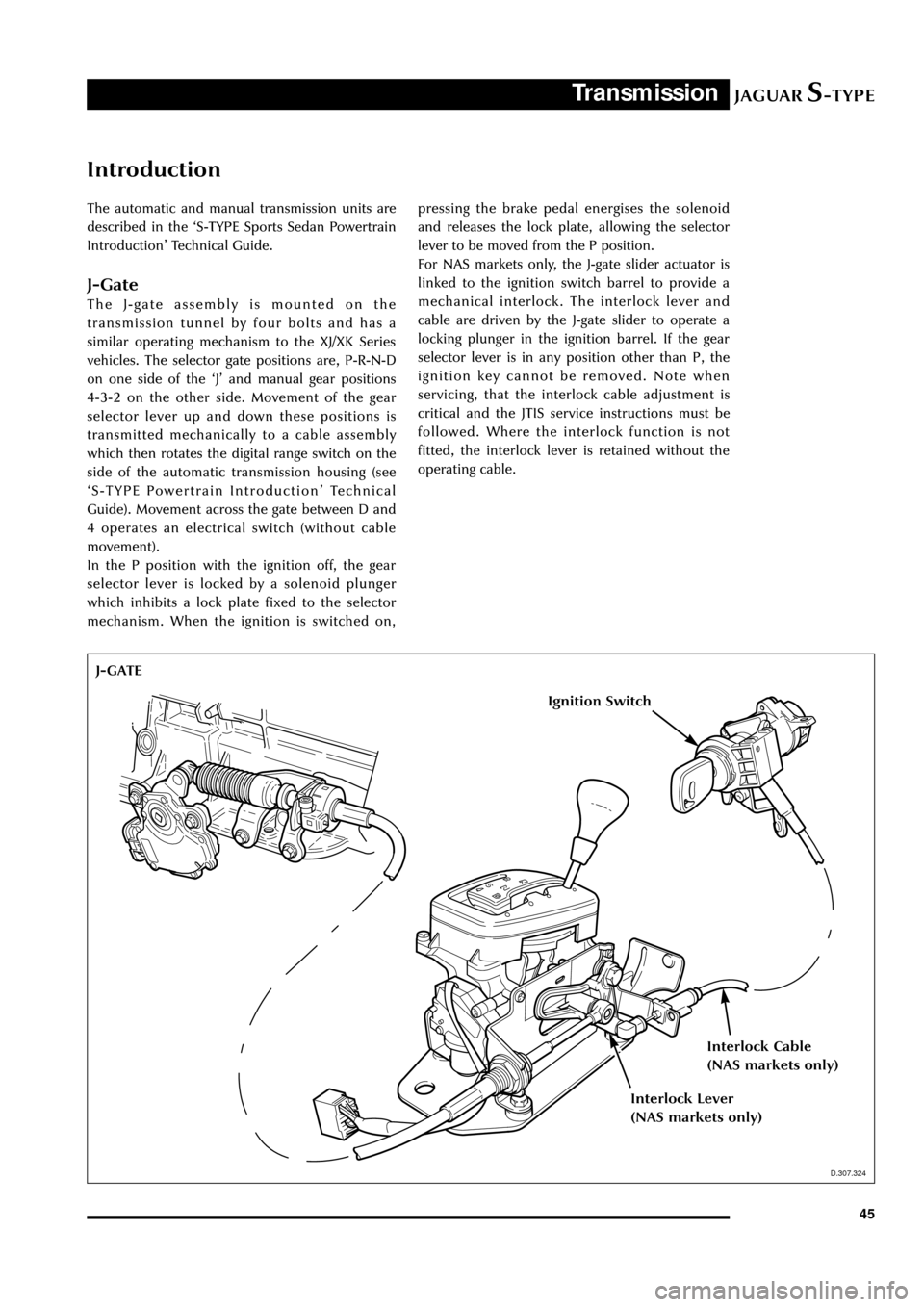
JAGUARS-TYPETransmission
45
Introduction
The automatic and manual transmission units are
described in the ÔS-TYPE Sports Sedan Powertrain
IntroductionÕ Technical Guide.
J-Gate
The J-gate assembly is mounted on the
transmission tunnel by four bolts and has a
similar operating mechanism to the XJ/XK Series
vehicles. The selector gate positions are, P-R-N-D
on one side of the ÔJÕ and manual gear positions
4-3-2 on the other side. Movement of the gear
selector lever up and down these positions is
transmitted mechanically to a cable assembly
which then rotates the digital range switch on the
side of the automatic transmission housing (see
ÔS-TYPE Powertrain IntroductionÕ Technical
Guide). Movement across the gate between D and
4 operates an electrical switch (without cable
movement).
In the P position with the ignition off, the gear
selector lever is locked by a solenoid plunger
which inhibits a lock plate fixed to the selector
mechanism. When the ignition is switched on,pressing the brake pedal energises the solenoid
and releases the lock plate, allowing the selector
lever to be moved from the P position.
For NAS markets only, the J-gate slider actuator is
linked to the ignition switch barrel to provide a
mechanical interlock. The interlock lever and
cable are driven by the J-gate slider to operate a
locking plunger in the ignition barrel. If the gear
selector lever is in any position other than P, the
ignition key cannot be removed. Note when
servicing, that the interlock cable adjustment is
critical and the JTIS service instructions must be
followed. Where the interlock function is not
fitted, the interlock lever is retained without the
operating cable.
D.307.324
J-GATE
Ignition Switch
Interlock Cable
(NAS markets only)
Interlock Lever
(NAS markets only)
D.307.324
Page 58 of 133

JAGUARS-TYPEChassis
53
Driveline
Introduction
The driveline is a standard type with the engine
position at the front and driven rear axle. This will
be the first time that Jaguar has used in-plant
driveline balancing to improve noise, vibration
and handling. The driveline is finely balanced at
the rear driveshaft joint. The centre bearing is
laser aligned during initial factory build.
The alloy rear engine mountings have two
variants, one for automatic transmission and one
for manual transmission. They are both
serviceable items. The V6 auto is the same as the
V8 but rotated in plan by 180 degrees. The rubber
mountings are carry over concept from the
current XJ and XK Series vehicles but are not
D.307.322
DRIVELINE ARRANGEMENTinterchangeable with them. Both automatic
transmission rubber mountings are common but
with a softer unique mount for the manual V6
transmission.
In service if they are replaced, ensure that there
are buffer gaps and that they are approximately
equal. Neither will be contaminated by lubricant
or automatic transmission fluid.
Driveshaft
The S-TYPE has a two-piece welded steel tube
driveshaft with a splined centre slip joint and
locking collar, the whole being aligned with the
body centreline. The driveshaft has rubber flex
couplings and a rubber, body-mounted, centre
bearing. For safety, the front tube is collapsible.
Page 81 of 133
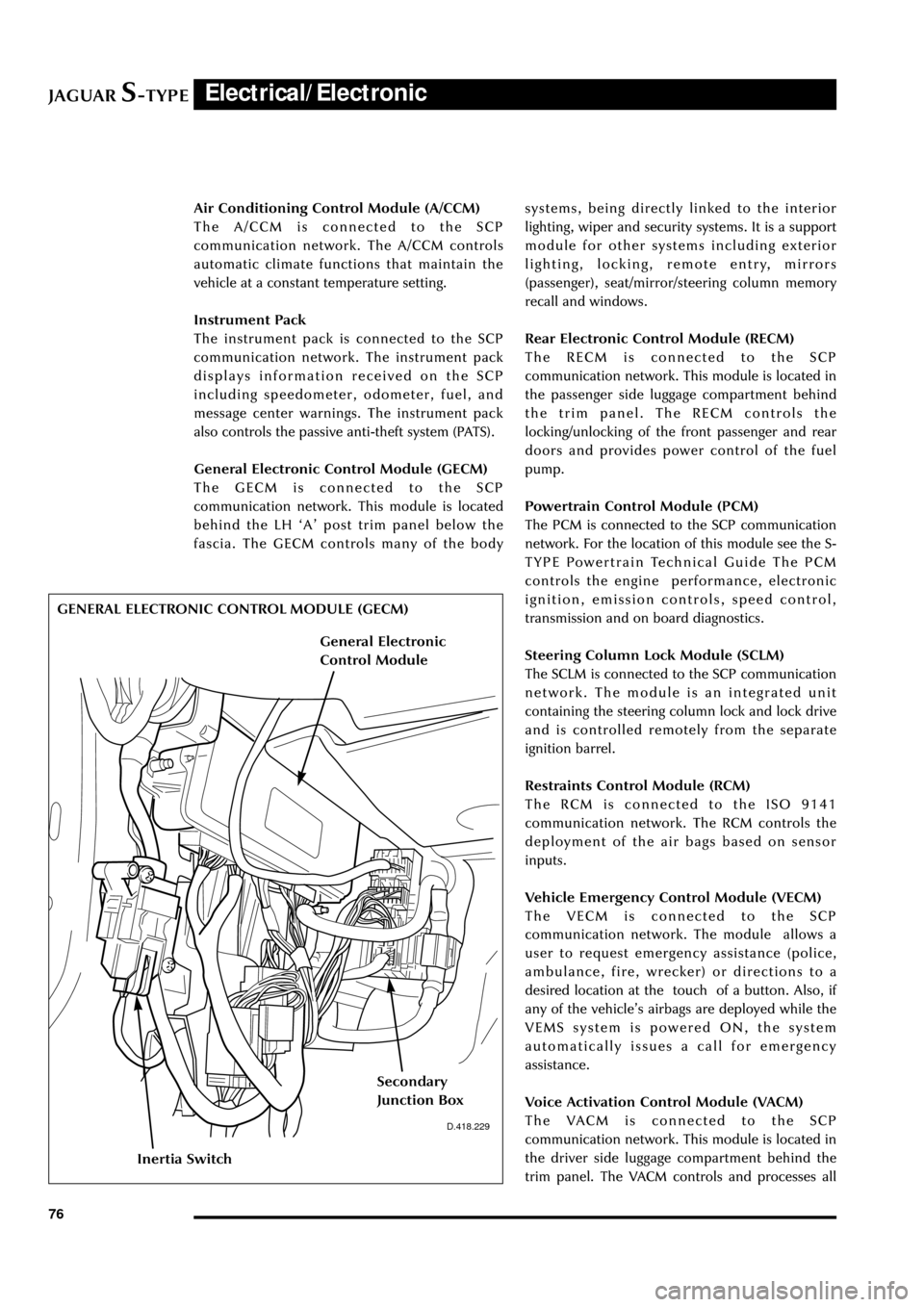
JAGUARS-TYPEElectrical/Electronic
76Air Conditioning Control Module (A/CCM)
The A/CCM is connected to the SCP
communication network. The A/CCM controls
automatic climate functions that maintain the
vehicle at a constant temperature setting.
Instrument Pack
The instrument pack is connected to the SCP
communication network. The instrument pack
displays information received on the SCP
including speedometer, odometer, fuel, and
message center warnings. The instrument pack
also controls the passive anti-theft system (PATS).
General Electronic Control Module (GECM)
The GECM is connected to the SCP
communication network. This module is located
behind the LH ÔAÕ post trim panel below the
fascia. The GECM controls many of the bodysystems, being directly linked to the interior
lighting, wiper and security systems. It is a support
module for other systems including exterior
lighting, locking, remote entry, mirrors
(passenger), seat/mirror/steering column memory
recall and windows.
Rear Electronic Control Module (RECM)
The RECM is connected to the SCP
communication network. This module is located in
the passenger side luggage compartment behind
the trim panel. The RECM controls the
locking/unlocking of the front passenger and rear
doors and provides power control of the fuel
pump.
Powertrain Control Module (PCM)
The PCM is connected to the SCP communication
network. For the location of this module see the S-
TYPE Powertrain Technical Guide The PCM
controls the engine performance, electronic
ignition, emission controls, speed control,
transmission and on board diagnostics.
Steering Column Lock Module (SCLM)
The SCLM is connected to the SCP communication
network. The module is an integrated unit
containing the steering column lock and lock drive
and is controlled remotely from the separate
ignition barrel.
Restraints Control Module (RCM)
The RCM is connected to the ISO 9141
communication network. The RCM controls the
deployment of the air bags based on sensor
inputs.
Vehicle Emergency Control Module (VECM)
The VECM is connected to the SCP
communication network. The module allows a
user to request emergency assistance (police,
ambulance, fire, wrecker) or directions to a
desired location at the touch of a button. Also, if
any of the vehicleÕs airbags are deployed while the
VEMS system is powered ON, the system
automatically issues a call for emergency
assistance.
Voice Activation Control Module (VACM)
The VACM is connected to the SCP
communication network. This module is located in
the driver side luggage compartment behind the
trim panel. The VACM controls and processes all
D.418.229
GENERAL ELECTRONIC CONTROL MODULE (GECM)
Inertia Switch
Secondary
Junction Box
General Electronic
Control Module
Page 105 of 133
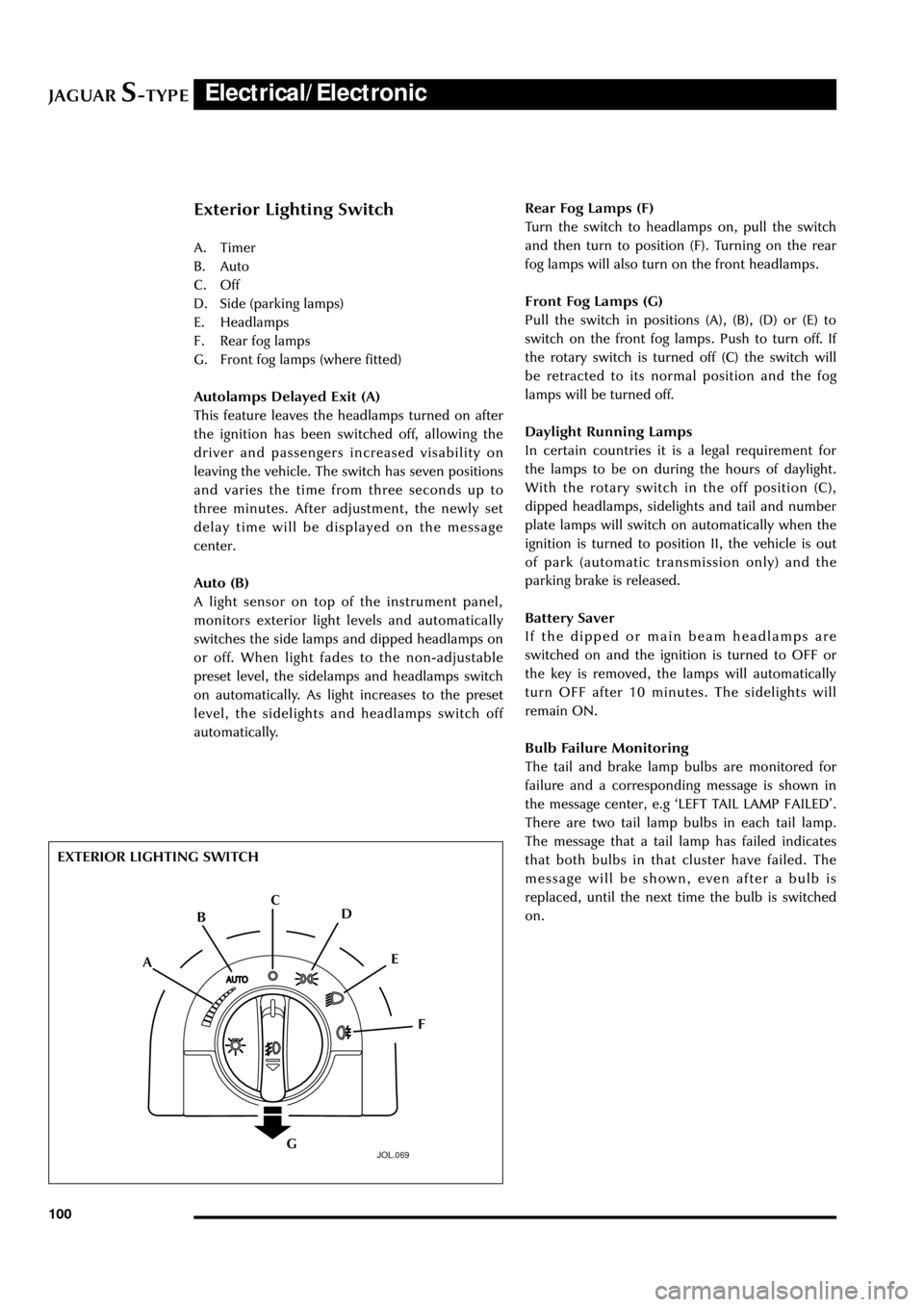
JAGUARS-TYPEElectrical/Electronic
100
Exterior Lighting Switch
A. Timer
B. Auto
C. Off
D. Side (parking lamps)
E. Headlamps
F. Rear fog lamps
G. Front fog lamps (where fitted)
Autolamps Delayed Exit (A)
This feature leaves the headlamps turned on after
the ignition has been switched off, allowing the
driver and passengers increased visability on
leaving the vehicle. The switch has seven positions
and varies the time from three seconds up to
three minutes. After adjustment, the newly set
delay time will be displayed on the message
center.
Auto (B)
A light sensor on top of the instrument panel,
monitors exterior light levels and automatically
switches the side lamps and dipped headlamps on
or off. When light fades to the non-adjustable
preset level, the sidelamps and headlamps switch
on automatically. As light increases to the preset
level, the sidelights and headlamps switch off
automatically.Rear Fog Lamps (F)
Turn the switch to headlamps on, pull the switch
and then turn to position (F). Turning on the rear
fog lamps will also turn on the front headlamps.
Front Fog Lamps (G)
Pull the switch in positions (A), (B), (D) or (E) to
switch on the front fog lamps. Push to turn off. If
the rotary switch is turned off (C) the switch will
be retracted to its normal position and the fog
lamps will be turned off.
Daylight Running Lamps
In certain countries it is a legal requirement for
the lamps to be on during the hours of daylight.
With the rotary switch in the off position (C),
dipped headlamps, sidelights and tail and number
plate lamps will switch on automatically when the
ignition is turned to position II, the vehicle is out
of park (automatic transmission only) and the
parking brake is released.
Battery Saver
If the dipped or main beam headlamps are
switched on and the ignition is turned to OFF or
the key is removed, the lamps will automatically
turn OFF after 10 minutes. The sidelights will
remain ON.
Bulb Failure Monitoring
The tail and brake lamp bulbs are monitored for
failure and a corresponding message is shown in
the message center, e.g ÔLEFT TAIL LAMP FAILEDÕ.
There are two tail lamp bulbs in each tail lamp.
The message that a tail lamp has failed indicates
that both bulbs in that cluster have failed. The
message will be shown, even after a bulb is
replaced, until the next time the bulb is switched
on.
JOL.069
EXTERIOR LIGHTING SWITCH
A
F E D C
B
G
Page 106 of 133
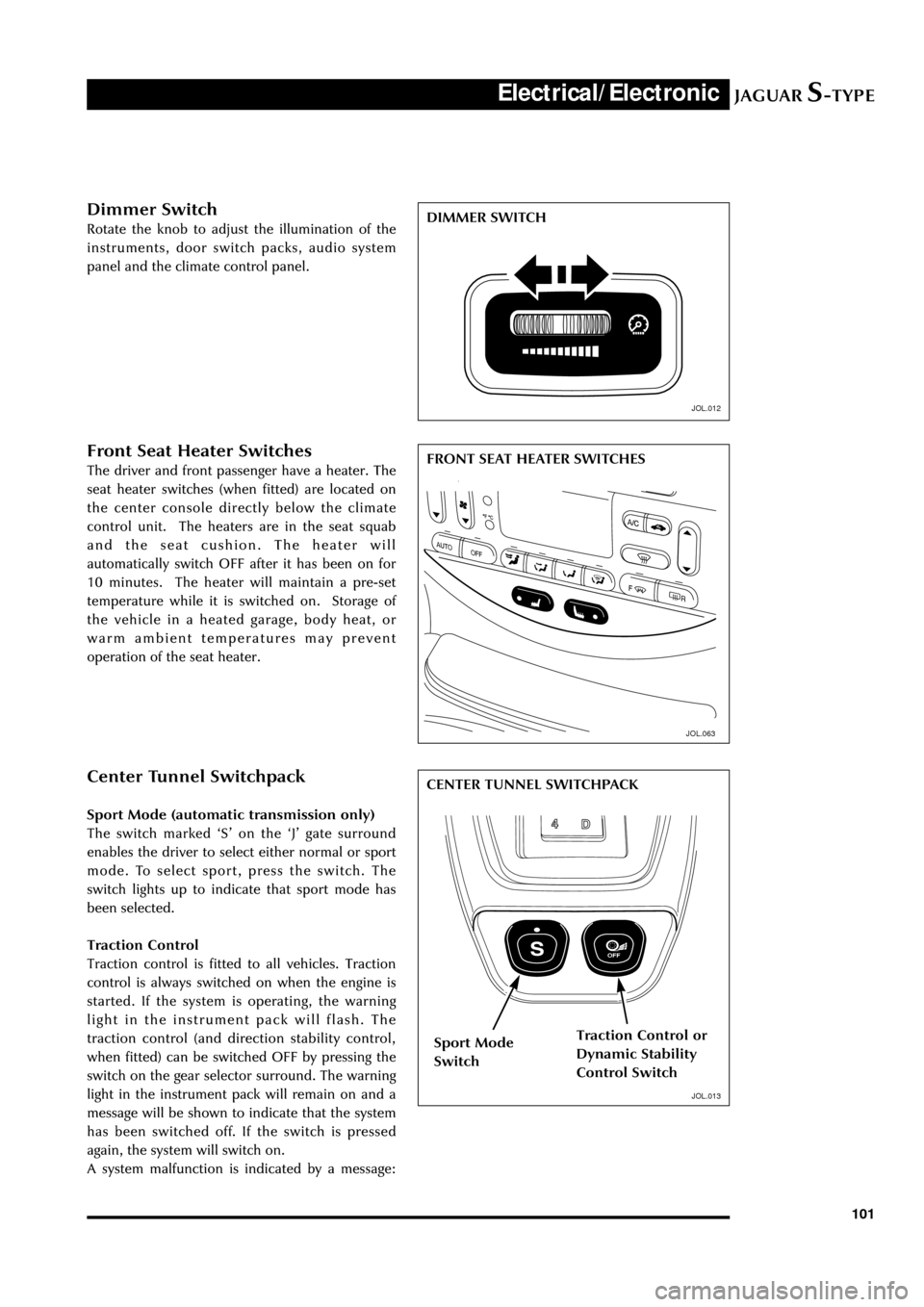
JAGUARS-TYPEElectrical/Electronic
101
Dimmer Switch
Rotate the knob to adjust the illumination of the
instruments, door switch packs, audio system
panel and the climate control panel.
JOL.063
Front Seat Heater Switches
The driver and front passenger have a heater. The
seat heater switches (when fitted) are located on
the center console directly below the climate
control unit. The heaters are in the seat squab
and the seat cushion. The heater will
automatically switch OFF after it has been on for
10 minutes. The heater will maintain a pre-set
temperature while it is switched on. Storage of
the vehicle in a heated garage, body heat, or
warm ambient temperatures may prevent
operation of the seat heater.
JOL.013
Center Tunnel Switchpack
Sport Mode (automatic transmission only)
The switch marked ÔSÕ on the ÔJÕ gate surround
enables the driver to select either normal or sport
mode. To select sport, press the switch. The
switch lights up to indicate that sport mode has
been selected.
Traction Control
Traction control is fitted to all vehicles. Traction
control is always switched on when the engine is
started. If the system is operating, the warning
light in the instrument pack will flash. The
traction control (and direction stability control,
when fitted) can be switched OFF by pressing the
switch on the gear selector surround. The warning
light in the instrument pack will remain on and a
message will be shown to indicate that the system
has been switched off. If the switch is pressed
again, the system will switch on.
A system malfunction is indicated by a message:DIMMER SWITCH
FRONT SEAT HEATER SWITCHES
CENTER TUNNEL SWITCHPACK
Sport Mode
SwitchTraction Control or
Dynamic Stability
Control Switch
JOL.012
JOL.013
Page 108 of 133

JAGUARS-TYPEElectrical/Electronic
103 Note: If the switches are held for longer than six
seconds, e.g. when attempting to overcome frozen
or jammed windows, the window drive will be
switched off for a few seconds to protect the
window drive motors.
Memory Setting (where fitted)
The position of the driverÕs seat, steering column
and exterior rear view mirrors can be memorized
and recalled. Two different driving position
profiles can be entered In the memory. The
switches for seat, mirror, steering column
adjustment and memory setting can be operated
with or without the key being in the ignition.
To store a driving position in the memory:
1. Adjust the seat, steering column an exterior
rear view mirrors to the desired position.
2. Push the memory button and the light in the
switch will illuminate
3. Within five seconds, push button Ô1Õ orÕ2Õ to
memorize the configuration. The memory
button light will go out and a chime will
indicate that the setting procedure is
complete. Additionally, if the ignition is on,
the message center will display a message
that the settings have been saved.
To recall a memorized position, the gear selector
lever must be in ÔPÕ or ÔNÕ on automatic
transmission vehicles and the park brake must be
applied on manual transmission vehicles. Press
and release the appropriate memory button (Ô1Õ or
Ô2Õ). The seat, steering column and door mirrors
will move automatically to the memorized
position.
The key ring transmitter can also be set to
memorize the position of the driverÕs seat,
steering column and exterior rear view mirrors.
Memory Recall Using a Key-ring Transmitter
The key-ring transmitter will recall a memory
position when the unlock button is pressed when
set as follows:
Adjust the seat, steering column and exterior rear
view mirrors to the desired position.
Press ÔmemoryÕ button.
Within five seconds, press any button on the key-
ring transmitter.
Press button Ô1Õ or Ô2Õ.
Repeat for the other transmitter, pressing the
remaining memory button.
To cancel key-ring transmitter memory recall:
Front Seat Adjustment Switchpacks
A key does not have to be in the ignition switch
for seat adjustment
A. Switch forward/rearward: moves seat cushion
forward or rearward
Switch up/down: raises/lowers front/rear of
cushion
B. Switch forward/rearward: raises/reclines angle
of seat squab
C. Switch front/rear: increases/reduces lumbar
support.
JOL.017
FRONT SEAT ADJUSTMENT SWITCHPACK
A
C B Press the ÔmemoryÕ button.
While the memory set light is ON, press any
button on the key-ring transmitter, (except the
panic button, if fitted), then press the ÔmemoryÕ
button again.
Page 117 of 133
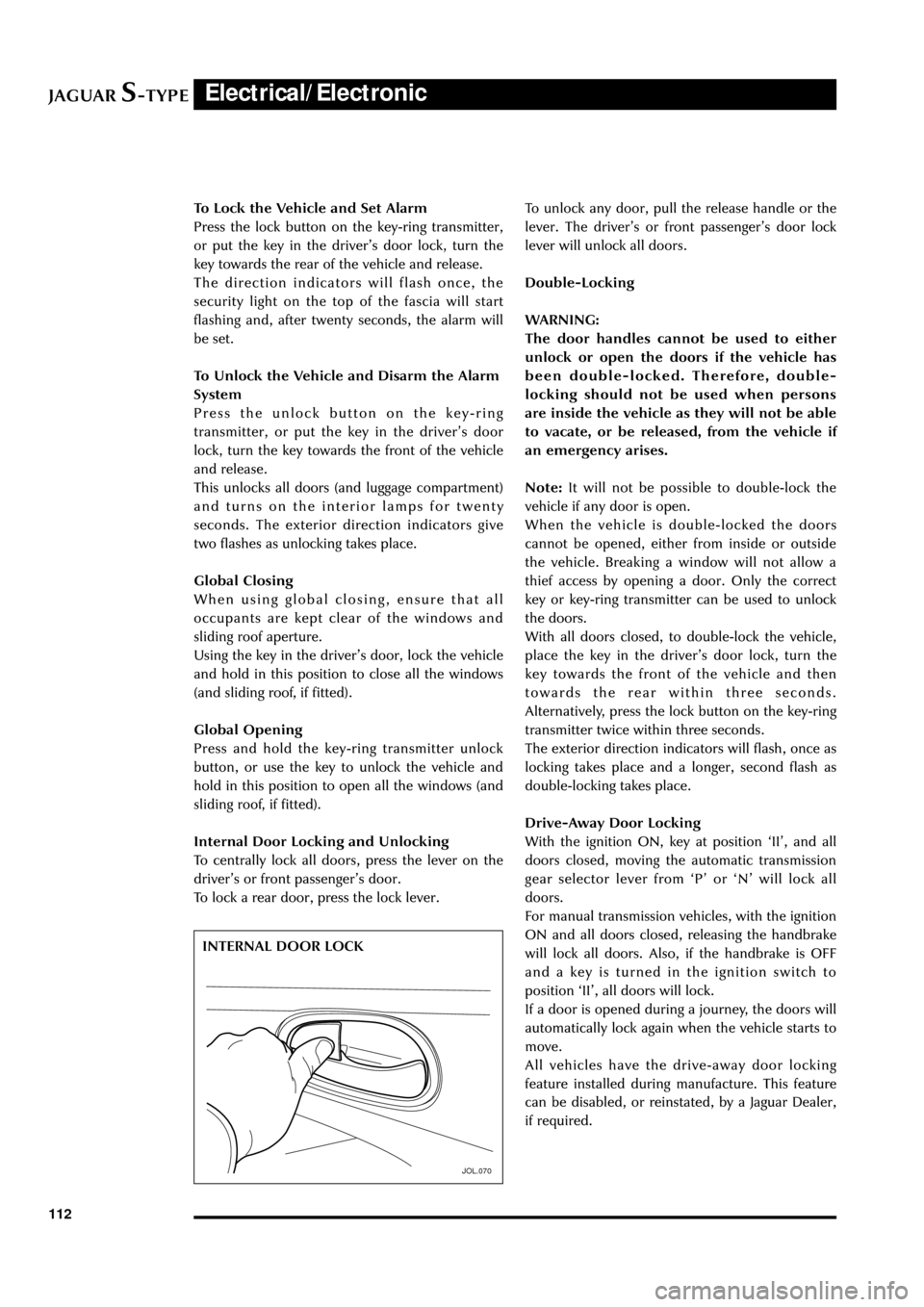
JAGUARS-TYPEElectrical/Electronic
112To Lock the Vehicle and Set Alarm
Press the lock button on the key-ring transmitter,
or put the key in the driverÕs door lock, turn the
key towards the rear of the vehicle and release.
The direction indicators will flash once, the
security light on the top of the fascia will start
flashing and, after twenty seconds, the alarm will
be set.
To Unlock the Vehicle and Disarm the Alarm
System
Press the unlock button on the key-ring
transmitter, or put the key in the driverÕs door
lock, turn the key towards the front of the vehicle
and release.
This unlocks all doors (and luggage compartment)
and turns on the interior lamps for twenty
seconds. The exterior direction indicators give
two flashes as unlocking takes place.
Global Closing
When using global closing, ensure that all
occupants are kept clear of the windows and
sliding roof aperture.
Using the key in the driverÕs door, lock the vehicle
and hold in this position to close all the windows
(and sliding roof, if fitted).
Global Opening
Press and hold the key-ring transmitter unlock
button, or use the key to unlock the vehicle and
hold in this position to open all the windows (and
sliding roof, if fitted).
Internal Door Locking and Unlocking
To centrally lock all doors, press the lever on the
driverÕs or front passengerÕs door.
To lock a rear door, press the lock lever.
JOL.070
INTERNAL DOOR LOCKTo unlock any door, pull the release handle or the
lever. The driverÕs or front passengerÕs door lock
lever will unlock all doors.
Double-Locking
WARNING:
The door handles cannot be used to either
unlock or open the doors if the vehicle has
been double-locked. Therefore, double-
locking should not be used when persons
are inside the vehicle as they will not be able
to vacate, or be released, from the vehicle if
an emergency arises.
Note:It will not be possible to double-lock the
vehicle if any door is open.
When the vehicle is double-locked the doors
cannot be opened, either from inside or outside
the vehicle. Breaking a window will not allow a
thief access by opening a door. Only the correct
key or key-ring transmitter can be used to unlock
the doors.
With all doors closed, to double-lock the vehicle,
place the key in the driverÕs door lock, turn the
key towards the front of the vehicle and then
towards the rear within three seconds.
Alternatively, press the lock button on the key-ring
transmitter twice within three seconds.
The exterior direction indicators will flash, once as
locking takes place and a longer, second flash as
double-locking takes place.
Drive-Away Door Locking
With the ignition ON, key at position ÔIIÕ, and all
doors closed, moving the automatic transmission
gear selector lever from ÔPÕ or ÔNÕ will lock all
doors.
For manual transmission vehicles, with the ignition
ON and all doors closed, releasing the handbrake
will lock all doors. Also, if the handbrake is OFF
and a key is turned in the ignition switch to
position ÔIIÕ, all doors will lock.
If a door is opened during a journey, the doors will
automatically lock again when the vehicle starts to
move.
All vehicles have the drive-away door locking
feature installed during manufacture. This feature
can be disabled, or reinstated, by a Jaguar Dealer,
if required.